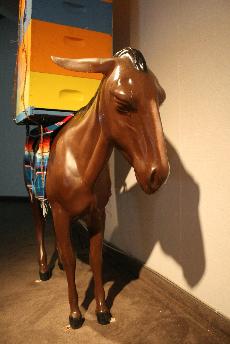Infectious cancer cells, a dying bee population, and manufactured golf courses created to mimic nature all spiral towards one common component- decay.
“Systems of Decay,” curated by artist Mark Garrett, showcases 11 versatile works of art that revolve around this solemn topic. With the theme open for interpretation, the six artists flexed their creative muscles and used chunks of wood, a camera lens, a computer animation and a bee colony to bring their creations to life – err, in this case, decay.
For artist David Kwan, his vision of decay was the disappearance and reappearance of landscapes in his piece, “Terminus.” “It’s a real-time composite of 25 different locations that I recorded up and down the Pacific Coast,” Kwan said. “Any four of these locations are being used to create a new landscape. “It’s an idea called ’emergence,’ which is used [when] there are different components that create a larger ecosystem.
And when one of those components changes, it affects the larger component in a dramatic way.”
While Kwan preferred to do things slowly in his one-hour video, Garrett and artist Joann Denning’s collaboration on “The Cancer on Gaia,” sped things up a little. Footage of the neighborhood in this animation alternates between fast forward and slow motion.
At each snail-paced interval, people in the shot change into black silhouettes that are infected by white cancer cells. “It’s about the principle of Gaia – about the earth being one organism,” Denning said. “We were exploring man’s relationship to Gaia, and we started to think on a cellular level about the systems in the body and the system in the planet.
“Our idea is that man is a part of Gaia but not necessarily a positive productive part. He could be considered like a cancer on the planet.”
While the Gaia principle was not obvious to all viewers, Garrett said he just wanted his audience to view things from a different angle. “I want people to question their own behavior a little bit,”he said. “Some people will be repulsed by the work – some of it is a little bit ugly. As long as it causes them to think about concepts like that, then I’m happy.”
Although not all the finished products are aesthetically appealing, each offers a unique perspective on the negative side of the topic.
But while “decay” has a negative connotation, one of the viewers pointed out that it’s not all that bad.
“It would’ve been nice to see the positive effects of decay,” said Jenn Balaian. “When you think about organic material, decaying is important to the cycle of life. Materials decay and decompose, which creates material for things to live again.”
Despite this, viewers gave generally positive comments about the show, walking away with newly acquired knowledge on how bees affect society, or a refreshing calm that only comes from watching a foggy shoreline at the break of dawn.
“Systems of Decay” runs through Sept. 19 in the DVC art gallery.





































































